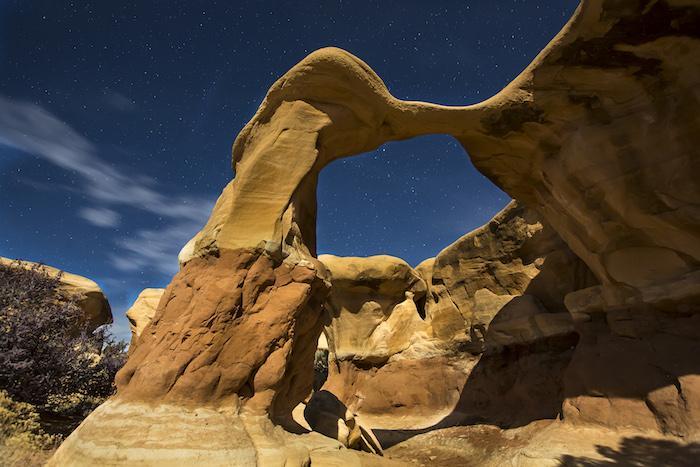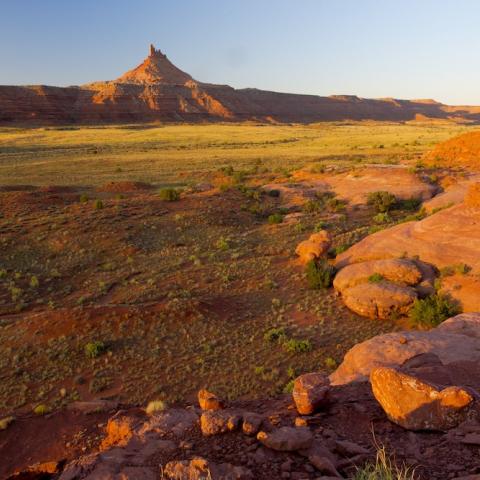
Metate Arch, Grand Staircase-Escalante National Monument/BLM
Editor's note: The following op-ed piece by Ron Maxwell initially ran on The American Conservative website.
The American people did not vote for Donald Trump because they wanted their forests logged, bounties placed on wolf packs, national monuments reduced in size, and a resumption of the universally outlawed ivory trade.
These odious policies are the direct result of the appointment of a swamp creature positioned by the crony class to further its own narrow financial interests and agenda: Interior Secretary Ryan Zinke. Thankfully the president reversed Zinke’s plans [1] for elephant trophies, calling them a “horror show,” which is what they are. But Trump recently traveled to Utah to announce the opening up of public lands [2] for commercial developers to pillage and plunder to their hearts content.
Bears Ears and Grand Staircase Escalante were first on the chopping block but Mr. Zinke has more in mind. At least eight more of our treasured national monuments, set aside for their beauty and the public’s enjoyment and use, are targeted for reduction. The Antiquities Act of 1906 gives the president the authority to set aside public lands as national monuments, and also to do the reverse. After reviewing these sites, Zinke has recommended that Trump reclassify and reduce the size of these national treasures.
No president has ever shrunk the sizes of monuments, but the Department of the Interior is filled with swamp denizens like Zinke and his deputy David Bernhardt, a former lobbyist for the oil and gas industry and big agribusiness, those most interested in using public land for private gain.
This reclassification means the acreage of the national monuments will be reduced, and the lands—some of the most spectacular scenic areas in the country—can be used for commercial development.
Unlike national parks, national monuments allow local residents and tourists alike to participate in recreational activities such as hunting, fishing, cattle-grazing, and hiking. This is why local businesses, sportsmen, and community groups tend to support keeping the monuments intact, as they provide dependable incomes for local economies, including the additions of jobs.
There is also widespread and bipartisan public support for preserving our national monuments. A new McLaughlin & Associates poll of 1,000 likely voters found that 90 percent of Americans support the creation of more monuments or at least keeping the current ones protected. Maintaining these lands also has the backing of local Native American tribes and chambers of commerce.
Organ Mountains-Desert Peaks in New Mexico is a prime example of how local areas surrounding national monuments can benefit from tourist opportunities. In 2016, tourism hit an all-time high following the monument’s mention in Lonely Planet’s “Top 10 Places to Visit” travel guide, which resulted in a 50 percent increase in visitors over the past year. The monument features petroglyph-line canyons, with thousands of Native American archeological sites, and many historical landmarks and training sites.
If the personal income of those who live near the Organ Mountains can increase by 42 percent, community involvement in supporting national monuments can lead to economic prosperity throughout the country.
Nonetheless, Secretary Zinke has recommended reclassifying Organ Mountains Desert Peaks for oil drilling and mining.
Gold Butte National Monument features significant cultural, historical, and natural treasures: thousands of Native American artifacts, historic mining and pioneering artifacts, rare and threatened wildlife, and dramatic geologic features. Broad and deep local support is a principal reason for its designation, which, in turn, has benefitted the community greatly.
Gold Butte also encourages tourism and increases expenditures for local businesses. An economic study conducted by Applied Analysis found that if only 10 percent of new visitors decided to spend one night in Mesquite, Nevada, the total economic impact for the community would be $2.7 million per year. Think about what that could mean if visitors were to spend the week.
Nevertheless, Secretary Zinke proposes that Gold Butte National Monument should be opened to “traditional uses,” including mining and drilling.
Aside from their captivating scenery and cultural and historical sites, monuments already provide an economic boost for nearby communities without risking damage to their environments. Additionally, their archaeological sites are a link to our prehistoric past and a vital tether to Native American cultural history.
Secretary Zinke’s misguided policies are toxic for local communities and even worse for American economic prosperity. President Trump knows business, but he also understands the need to protect these lands and the local economies they serve. He is wise to question the plans of his swamp creature and should continue to do so.
Ron Maxwell is writer and director of the award-winning film Gettysburg.



 Support Essential Coverage of Essential Places
Support Essential Coverage of Essential Places







Comments
But Rick. Had you lived in Alaska at any time in the past 15,000 years, you could have said the same thing. Oh, my God! There goes the Bering Land Bridge!
A planet 4.5 billion years old is never going to listen to us. The California drought? I lived through a bad one between 1976 and 1978. Even in good years, southern California averages just 17 inches of precipitation. Without water from northern California and the Colorado River, there would be no California. Read CADILLAC DESERT, by the late Marc Reisner. Even in 1971, I was teaching the absurdity of California to my students at UC Santa Barbara. Then the plan was to "import" water from Alaska, using Canada's Rocky Mountain Trench as the major distribution point. NAWAPA it was called (North American Water & Power Alliance). The prediction? California would run out of water without it. True enough, but who had the trillion dollars to build it? And those dollars were being calculated in 1971.
We will never run out of predictions, but we have certainly run out of common sense. There is nothing anyone can do about it. Human beings are NOT in control.
What is? The laws of physics and diminishing returns. There is no free lunch. You never get something for nothing. Everything you do has a consequence. You can't just erase CO2 with another technological fix. The fix a century ago was dams and hydroelectric power, until finally, hoping to make uninhabitable states "habitable," engineers asked us to believe that "water flows uphill toward money." If we spent enough, we could do anything we wanted. God was not in control.
With that, we took out practically every free-flowing river in the nation, and now the dam builders have nothing to do. However, they can always pour concrete for wind farms (each turbine needs a base as big as a house). So yes, there's lots of opportunity left for ripping off the taxpayers. We just have to find the right cliche.
Only Mr. Trump won't allow us to use it. He dares call climate change a hoax. No, it's not a hoax, but it sure is something that's been totally abused, as was NAWAPA in the 1970s.
Rick asks what I've been reading, teaching, and writing. Well, here it comes again. Do read 25 MYTHS THAT ARE DESTROYING THE ENVIRONMENT, by my dear friend, the scientist, Daniel Botkin. I wrote the introduction and helped Dr. Botkin find a credible publisher--mine, Rowman & Littlefield. Dan's latest invitation to speak, based on his book, will be to the Idaho Foresters Forum. They write: "Daniel, Thursday, February 8 is our big attendance day with over 200 resource professionals primarily Forester's for state, industry and tribal organizations. We have four concurrent sessions running three times during that day with a keynote in the morning and a closing speaker in the afternoon.
I have personally read your book the 25 Myths and have shared it with many of my staff, clients and resource professionals as we feel it is very appropriate and needed at this time in our efforts to do effective resource management."
Hmmm. They sound like "real" scientists to me. Congratulations, Dan, and by the way: His son Jonathan works in the field of renewable energy, having earned degrees in mechanical engineering.
These are the serious people--the serious thinkers. It's not about predictions announced on CNN. Dan admits he might be wrong. Any good scholar has that humility. But there it is--a book all of you might read that goes deep into the problem without insulting the reader who happens to disagree.
Argalite, did not Al Gore predict the artic ice cap would be gone by 2013? Didn't his film dramatically feature a polar bear on an ice floe indicating melting ice caps were a threat to their existance (there are more today than at that time. As to California droughts and fires. Has happened many times in the past. There is no evidence that California, much less the US or world is experiencing any droughts and fires outside the usual cycle. The only real difference in the fires is that more assets are at risk and the fires may be more intense because of prior fire suppression efforts. After all the at is what the science said - "don't let the fires burn".
I don't know what Al Gore did or didn't do. I read science publications. No one suggests ice caps gone this soon from the UN sciencce pages. Longest fire season since keeping records in CA. Usual cycle? Tell me about that
Oh so Al (the face of the AGW hoax) didn't base his predictions on "science"? Good to know that you are admitting that. So tell me, what "science publications" did you read 10 years ago and what were their predictions? Longest season "since keeping records"? How long have they been keeping records? Oh, and by the way, this years fires have been attributed to the excessive moisture (not drought) last winter that lead to much greater vegetation.
Gone no, but they did predict they were at risk, would be diminishing and could be gone by 2040. Like most AGW predictions, they were wrong. The polar bears are doing just fine.
https://polarbearscience.com/2016/09/13/recent-studies-show-sept-ice-of-...
"Oh, and by the way, this years fires have been attributed to the excessive moisture (not drought) last winter that lead to much greater vegetation. "
Very obvious from that comment that someone out there has absolutely NO understanding or knowledge of wildland fire and lands management.
Lee how wrong you are. I am actively involved in fire mitigation efforts here in Summit County, have represented the Town of Breckenridge in formulating Firewise regulations and have consulted with the chief fire scientist for the National Forest Service (Jack Cohen) and meet and speak on a regular basis with representative of the local fire department and state fire officials regarding WUI issues. They get most concerned after a very moist period. Grasses and shrubs grow dense in such an environment and then create a larger fire hazard when the normal dry periods occur.
Lots of rain last winter = more wildfire fuel
This seems counterintuitive, since rain should suppress wildfires. But from October 2016 to May 2017, record amounts of rain fell in the northern Sierra Mountain region, prompting grass, brush and trees to grow like they haven't been able to in decades.
The new growth is now serving as fuel for this fire season, made worse by five months in a row of extremely dry weather.
https://www.washingtonpost.com/news/capital-weather-gang/wp/2017/10/10/t...
But using the term "excessive moisture" shot the whole comment down. Now that drought has apprently returned, the fine fuels that resulted from a short and temporary spell of wet weather are again tinder dry. Fire managers understand and try to deal properly with those kinds of things. A short burst of dampness does not cancel the effects of Global Warming.